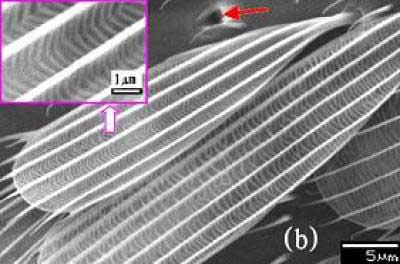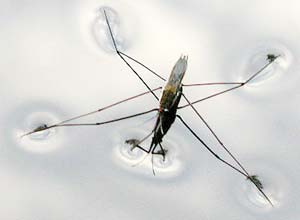Why do mosquitoes walk on water and on walls?
Mosquitoes can be blood-sucking, pathogenic, uncomfortable creatures, but they have a pair of animals that no animal can: walk on the wall and walk under water.
Other insects, such as flies, can also go upside down on surfaces, but once they land on the water, they spend life. Another group of insects, like water spiders, stepped on the water easily, but when climbing up on the wall, they fell back onto the ground.
But mosquitoes can both stand on 2 surfaces; walls and ceilings are a good place for them to flee the enemy, and the water surface is where they spawn."They are born underwater and undergo larval stages, so mosquitoes must lay eggs on the water," David Hu said.
So how do mosquitoes stand on such different surfaces?

Small trenches contain air spaces on the hairs of mosquitoes. (Photo: Livescience)
Each mosquito has a special leg pad, similar to a fly, which has a hard, fluffy structure that easily adheres to the vertical or upside-down surface. But this bristle structure is completely useless on the water.
Water spiders, parked on the surface of the water, waiting for the bait to fall in and jump out, are experts in water cycling in the animal kingdom. The tiny hairs covering each mm on their feet make it difficult for water to penetrate. Mosquitoes do not have this coat, but they have grooves that include air holes on their legs. Face tension

(Photo: wldelft.nl)
water makes it difficult to absorb water through these trenches, making the mosquitoes always dry and floating.
"The smaller the grooves are, the harder it will be to absorb water , " Hu said. The new study found that each mosquito foot can hold 23 times the weight of a mosquito.
When water spiders and mosquitoes stand on the water, their feet form a hollow, and the water tension keeps them rising . "Water always seeks to minimize the surface of the air exposed. That means it acts like a trampoline, sunken and supporting the weight of the organism," Hu explained.
Unfortunately, this rule makes large creatures like humans unable to stand on water. The bigger the organism, the smaller the contact surface corresponds to weight, so there are very few surfaces that can take advantage of the water tension to support the weight of the subject.
"If you want to calculate the size of your feet enough to help you stand on the water, it must be about a kilometer long , " Hu said.
So if you are trying to walk from the edge of the water, you will surely fall down."We are so big that the surface tension is meaningless. But when you are a small insect, it is everything to you," Hu said.

Water spiders belonging to Ptilomera species were discovered in Thailand
(Photo: LiveScience)
MT
- The reason people can't walk through walls
- Evade mosquitoes by infrared wall
- Interesting findings about mosquitoes
- Mosquitoes 'horror' do not crave human blood
- Mosquitoes raging in Bangkok
- Astronauts postpone walking because the water in the hat
- Equipment to help ordinary people into spiders
- 10 interesting things about mosquitoes
- Why do humans not erase mosquitoes?
- Reveal the secret to help people walk on the water
- Why do mosquitoes love to burn humans?
- Change the sex of the mosquito
 Why do potatoes have eyes?
Why do potatoes have eyes? 'Tragedy' the world's largest carnivorous life: Death becomes ... public toilet
'Tragedy' the world's largest carnivorous life: Death becomes ... public toilet Tomatoes were once considered 'poisonous' for 200 years
Tomatoes were once considered 'poisonous' for 200 years Detecting microscopic parasites on human face
Detecting microscopic parasites on human face